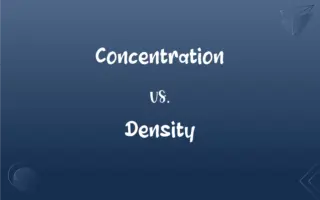Copper Oxychloride vs. Copper Sulphate: What's the Difference?
Edited by Aimie Carlson || By Janet White || Published on January 16, 2024
Copper oxychloride is a greenish agricultural fungicide, while copper sulphate is a blue crystalline compound used in agriculture and industry.

Key Differences
Copper oxychloride, a compound of copper, chlorine, and oxygen, is known for its use in agriculture as a fungicide. Copper sulphate, composed of copper and sulphate ions, is used not only in agriculture but also in various industrial applications.
Copper oxychloride serves primarily as a fungicide to control plant diseases. Copper sulphate, while also used as a fungicide and herbicide, has broader applications, including as a soil additive to correct copper deficiencies.
Copper oxychloride appears as a greenish powder and adheres well to plant surfaces, providing prolonged protection. Copper sulphate, known for its distinctive blue crystals, is highly soluble in water, making it useful in solutions.
Apart from agriculture, copper oxychloride's use in industry is limited. In contrast, copper sulphate is used in electroplating, as an algicide in water treatment, and in various chemical processes.
Both compounds require careful handling due to toxicity risks. Copper sulphate, being more soluble, poses a higher risk of leaching into water systems, affecting aquatic life.
ADVERTISEMENT
Comparison Chart
Composition
Copper, chlorine, oxygen
Copper, sulphate ions
Primary Use
Fungicide in agriculture
Fungicide, herbicide, soil additive
Physical Form
Greenish powder
Blue crystals
Solubility
Less soluble, adheres to surfaces
Highly soluble in water
Additional Applications
Limited industrial use
Electroplating, water treatment, chemical processes
ADVERTISEMENT
Copper Oxychloride and Copper Sulphate Definitions
Copper Oxychloride
Composed of copper, chlorine, and oxygen.
The formula of copper oxychloride makes it effective against a range of plant diseases.
Copper Sulphate
Applied in water treatment and electroplating.
The water treatment plant uses copper sulphate for controlling algae.
Copper Oxychloride
Used for controlling fungal diseases in crops.
To combat mildew, copper oxychloride was applied to the crops.
Copper Sulphate
Comprises copper and sulphate ions.
The chemical structure of copper sulphate enables diverse applications.
Copper Oxychloride
Adheres well to plant surfaces for prolonged protection.
The lasting effect of copper oxychloride is beneficial for crop protection.
Copper Sulphate
Highly soluble in water, used in solutions.
A solution of copper sulphate was prepared for electroplating.
Copper Oxychloride
A greenish agricultural fungicide.
Copper oxychloride was sprayed on the vines to prevent fungal infections.
Copper Sulphate
A blue crystalline compound used in agriculture and industry.
Copper sulphate was added to the pond as an algicide.
Copper Oxychloride
Requires careful handling due to toxicity.
While using copper oxychloride, farmers wear protective gear for safety.
Copper Sulphate
Used as a fungicide, herbicide, and soil additive.
To address copper deficiency, copper sulphate was applied to the soil.
FAQs
What is copper oxychloride?
It's a greenish powder used as a fungicide in agriculture.
What are the uses of copper sulphate?
It's used as a fungicide, herbicide, soil additive, in electroplating, and water treatment.
Can copper sulphate be used in ponds?
Yes, as an algicide to control algae growth.
What crops benefit from copper oxychloride?
It's used on a variety of crops, especially for fungal disease control.
Is copper oxychloride soluble in water?
It has limited solubility and adheres well to plant surfaces.
How is copper sulphate used in agriculture?
As a fungicide, herbicide, and to correct copper deficiencies in soils.
What industries use copper sulphate?
It's used in agriculture, electroplating, water treatment, and chemical manufacturing.
Can copper oxychloride be used indoors?
It's primarily used outdoors due to its toxicity and application method.
What safety precautions are needed for copper oxychloride?
Protective clothing and adherence to usage guidelines are essential.
Is copper oxychloride toxic?
Yes, it can be toxic and requires careful handling.
Why is copper sulphate blue?
The blue color is due to its chemical composition of copper and sulphate ions.
How does copper oxychloride work as a fungicide?
It disrupts fungal growth and spore formation on plants.
Can copper oxychloride affect human health?
Yes, if not handled properly, it can be harmful.
How does copper sulphate affect aquatic life?
Being highly soluble, it can leach into water systems and is toxic to aquatic organisms.
Is copper oxychloride used in residential gardening?
Yes, but with caution due to its toxicity.
Is copper sulphate effective against all plant diseases?
It's effective against many, but not all, particularly fungal diseases.
How does copper sulphate correct soil deficiencies?
It provides essential copper nutrients to the soil.
What are the storage requirements for copper sulphate?
It should be stored in a dry, cool place away from direct sunlight.
Can copper sulphate treat tree diseases?
Yes, it's used for fungal diseases in trees.
How is copper oxychloride applied to crops?
Typically as a spray mixed with water.
About Author
Written by
Janet WhiteJanet White has been an esteemed writer and blogger for Difference Wiki. Holding a Master's degree in Science and Medical Journalism from the prestigious Boston University, she has consistently demonstrated her expertise and passion for her field. When she's not immersed in her work, Janet relishes her time exercising, delving into a good book, and cherishing moments with friends and family.
Edited by
Aimie CarlsonAimie Carlson, holding a master's degree in English literature, is a fervent English language enthusiast. She lends her writing talents to Difference Wiki, a prominent website that specializes in comparisons, offering readers insightful analyses that both captivate and inform.






































































